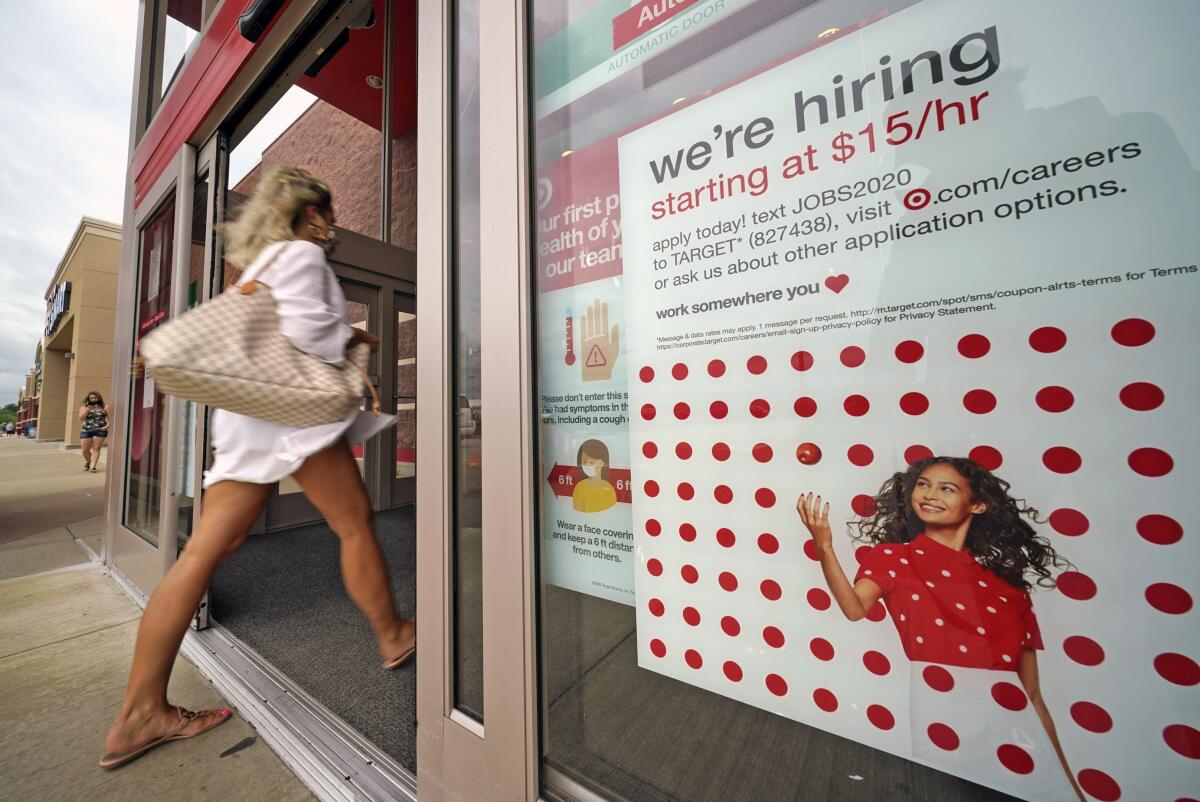COVID-19 danger continues to drive joblessness in U.S.

- Share via
WASHINGTON — The number of Americans applying for unemployment benefits fell last week to 860,000, a historically high figure that reflects economic damage from the coronavirus outbreak.
Before the pandemic hit, the number of new jobless claims had never exceeded 700,000 in a week, even during the depths of the 2007-09 Great Recession. Now they’ve topped 700,000 for 26 straight weeks.
The Labor Department said Thursday that claims fell by 33,000 from the previous week and that 12.6 million are collecting traditional unemployment benefits, compared with just 1.7 million a year ago.
The pandemic has delivered a colossal shock to the economy, with the gross domestic product shrinking at an annual rate of 31.7% from April through June, by far the worst three months on record, as millions of jobs disappeared.
The economy and job market have recovered somewhat from the initial shock. Employers added 10.6 million jobs from May through August, but that’s still less than half the jobs lost in March and April.
The recovery remains fragile, imperiled by continuing COVID-19 infections as schools begin to reopen, and the failure to deliver another economic rescue package in Washington.
An extra $600 in weekly unemployment benefits ran out July 31, squeezing households that had depended on the beefed-up payments. President Trump issued an executive order Aug. 8 providing a scaled-back version of the expanded jobless aid. Most states signed up for federal grants that let them increase weekly benefits by $300 or $400.
That program is expiring.
Charissa Ward, 37, was furloughed in April from her job as a server at a restaurant in Disney’s Hollywood Studios resort near Orlando, Fla. Since then, she’s been helping at her partner’s online retail business, applying for jobs and waiting to see what Disney will do. “We have no idea when we’re going to get called back,’’ she said.
The extra $600 in weekly jobless benefits didn’t replace all her lost income, but it helped. The reduced $300 she received briefly from Trump’s program made life “a little less stressful.’’ But Ward said Congress needs to agree to another financial rescue and do “what’s best for working people.’’
Last week, nearly 659,000 people applied for jobless aid under a new program that extends eligibility for the first time to self-employed and gig workers, down from 868,000 the previous week. The figure for those seeking Pandemic Employment Assistance isn’t adjusted for seasonal trends, so it’s reported separately.
Altogether, the Labor Department said that 29.8 million people are receiving some form of unemployment benefits, though the figure may be inflated by double-counting by states. Analysts also worry about evidence that the number of people collecting special pandemic aid has been swollen by cases of fraud in California.
A summertime resurgence of COVID-19 cases in the South and West forced many businesses to close again in July — though the data firm Womply finds that closings have mostly stabilized over the last few weeks. Womply did find a sharp increase in spending at bars in Southern and Western states, including South Carolina, Tennessee and Alabama, as college students returned to campus.
Unemployment claims “remain high even as economic activity is resuming more fully,” Rubeela Farooqi, chief U.S. economist at High Frequency Economics, wrote Thursday. “The risk going forward continues to come from virus outbreaks and intermittent interruptions to activity. Overall, the labor market is less weak compared to April but remains at risk of permanent damage from repeated closures.’’
More to Read
Inside the business of entertainment
The Wide Shot brings you news, analysis and insights on everything from streaming wars to production — and what it all means for the future.
You may occasionally receive promotional content from the Los Angeles Times.








